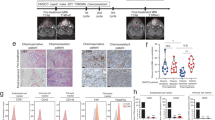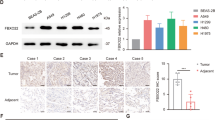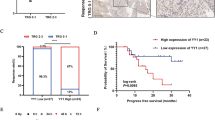Abstract
Conventional therapies including radiation therapy cannot cure squamous cell carcinoma (SCC), and new treatments are clearly required. Our recent studies have shown that SCC cell lines exhibiting radioresistance show significant upregulation of the fibroblast growth factor receptor 3 (FGFR3) gene. We hypothesized that inhibiting FGFR3 would suppress tumor cell radioresistance and provide a new treatment approach for human SCCs. In the present study, we found that RNA interference-mediated FGFR3 depletion in HSC-2 cells, a radioresistant cell line, induced radiosensitivity and inhibited tumor growth. Use of an FGFR3 inhibitor (PD173074) obtained similar results with suppression of the autophosphorylation extracellular signal-regulated kinase pathway in HSC-2 cells and lung cancer cell lines. Moreover, the antitumor growth effect of the combination of PD173074 and radiation in vivo was also greater than that with either drug alone or radiation alone. Our results provided novel information on which to base further mechanistic study of radiosensitization by inhibiting FGFR3 in human SCC cells and for developing strategies to improve outcomes with concurrent radiotherapy.
This is a preview of subscription content, access via your institution
Access options
Subscribe to this journal
Receive 50 print issues and online access
$259.00 per year
only $5.18 per issue
Buy this article
- Purchase on Springer Link
- Instant access to full article PDF
Prices may be subject to local taxes which are calculated during checkout




Similar content being viewed by others
References
Bar-Sagi D, Feramisco JR . (1985). Microinjection of the ras oncogene protein into PC12 cells induces morphological differentiation. Cell 42: 841–848.
Chesi M, Nardini E, Brents LA, Schröck E, Ried T, Kuehl WM et al. (1997). Frequent translocation t(4;14)(p16.3;q32.3) in multiple myeloma is associated with increased expression and activating mutations of fibroblast growth factor receptor 3. Nat Genet 16: 260–264.
Eswarakumar VP, Lax I, Schlessinger J . (2005). Cellular signaling by fibroblast growth factor receptors. Cytokine Growth Factor Rev 16: 139–149.
Fowler JF, Denekamp J, Delapeyre C, Harris SR, Sheldon PW . (1974). Skin reactions in mice after multifraction x-irradiation. Int J Radiat Biol 25: 213–223.
Friesel RE, Maciag T . (1995). Molecular mechanisms of angiogenesis: fibroblast growth factor signal transduction. FASEB J 9: 919–925.
Henson BJ, Gollin SM . (2010). Overexpression of KLF13 and FGFR3 in oral cancer cells. Cytogenet Genome Res 128: 192–198.
Ishigami T, Uzawa K, Higo M, Nomura H, Saito K, Kato Y et al. (2007). Genes and molecular pathways related to radioresistance of oral squamous cell carcinoma cells. Int J Cancer 120: 2262–2270.
Johnson DE, Williams LT . (1993). Structural and functional diversity in the FGF receptor multigene family. Adv Cancer Res 60: 1–41.
Knowles MA . (2008). Novel therapeutic targets in bladder cancer: mutation and expression of FGF receptors. Future Oncol 4: 71–83.
Koziczak M, Holbro T, Hynes NE . (2004). Blocking of FGFR signaling inhibits breast cancer cell proliferation through downregulation of D-type cyclins. Oncogene 23: 3501–3508.
Masih-Khan E, Trudel S, Heise C, Li Z, Paterson J, Nadeem V et al. (2006). MIP-1alpha (CCL3) is a downstream target of FGFR3 and RAS-MAPK signaling in multiple myeloma. Blood 15: 3465–3471.
Noda M, Ko M, Ogura A, Liu DG, Amano T, Takano T et al. (1985). Sarcoma viruses carrying ras oncogenes induce differentiation-associated properties in a neuronal cell line. Nature 318: 73–75.
Pardo OE, Latigo J, Jeffery RE, Nye E, Poulsom R, Spencer-Dene B et al. (2009). The fibroblast growth factor receptor inhibitor PD173074 blocks small cell lung cancer growth in vitro and in vivo. Cancer Res 15: 8645–8651.
Rosty C, Aubriot MH, Cappellen D, Bourdin J, Cartier I, Thiery JP et al. (2005). Clinical and biological characteristics of cervical neoplasias with FGFR3 mutation. Mol Cancer 4: 15.
Shintani S, Li C, Mihara M, Terakado N, Yano J, Nakashiro K . (2003). Enhancement of tumor radioresponse by combined treatment with gefitinib (Iressa, ZD1839), an epidermal growth factor receptor tyrosine kinase inhibitor, is accompanied by inhibition of DNA damage repair and cell growth in oral cancer. Int J Cancer 107: 1030–1037.
Studer G, Zwahlen RA, Graetz KW, Davis BJ, Glanzmann C . (2007). IMRT in oral cavity cancer. Radiat Oncol 2: 16.
Toulany M, Kasten-Pisula U, Brammer I, Wang S, Chen J, Dittmann K . (2006). Blockage of epidermal growth factor receptor-phosphatidylinositol 3-kinase-AKT signaling increases radiosensitivity of K-RAS mutated human tumor cells in vitro by affecting DNA repair. Clin Cancer Res 12: 4119–4126.
Trudel S, Ely S, Farooqi Y, Affer M, Robbiani DF, Chesi M et al. (2004). Inhibition of fibroblast growth factor receptor 3 induces differentiation and apoptosis in t(4;14) myeloma. Blood 103: 3521–3528.
Acknowledgements
We thank Lynda C Charters for proofreading this manuscript. This work was supported by a grant-in-aid from the Ministry of Education, Science, Sports and Culture of Japan (no. 22659364), a grant-in-aid from the Japan Society for Promotion of Science Fellows (1952163), a grant-in-aid for Exploratory Research (19659520) and the 21st Century Center of Excellence Programs grant.
Author information
Authors and Affiliations
Corresponding author
Ethics declarations
Competing interests
The authors declare no conflict of interest.
Rights and permissions
About this article
Cite this article
Uzawa, K., Ishigami, T., Fushimi, K. et al. Targeting fibroblast growth factor receptor 3 enhances radiosensitivity in human squamous cancer cells. Oncogene 30, 4447–4452 (2011). https://doi.org/10.1038/onc.2011.159
Received:
Revised:
Accepted:
Published:
Issue Date:
DOI: https://doi.org/10.1038/onc.2011.159
Keywords
This article is cited by
-
Effects of FGFR inhibitors TKI258, BGJ398 and AZD4547 on breast cancer cells in 2D, 3D and tissue explant cultures
Cellular Oncology (2021)
-
Resveratrol Targets Urokinase-Type Plasminogen Activator Receptor Expression to Overcome Cetuximab-Resistance in Oral Squamous Cell Carcinoma
Scientific Reports (2019)
-
SOX2 activation predicts prognosis in patients with head and neck squamous cell carcinoma
Scientific Reports (2018)
-
Evaluation of FGFR3 as a Therapeutic Target in Head and Neck Squamous Cell Carcinoma
Targeted Oncology (2016)
-
Fibroblast Growth Factor Receptor Family Members as Prognostic Biomarkers in Head and Neck Squamous Cell Carcinoma: A Systematic Review
Targeted Oncology (2016)



